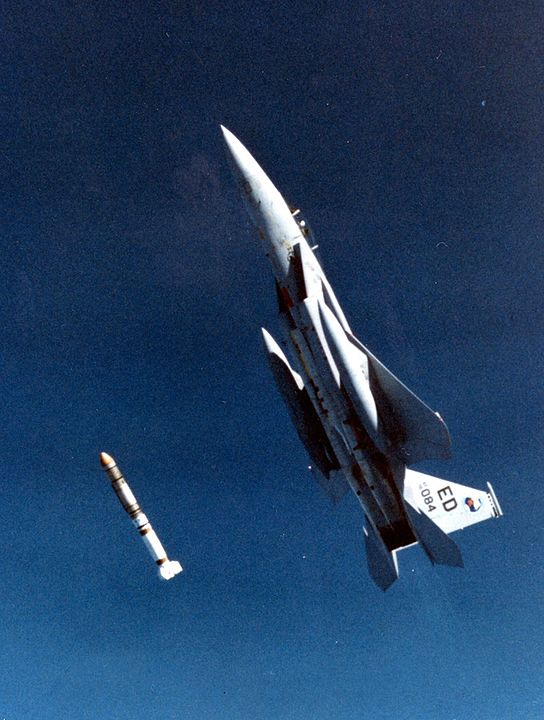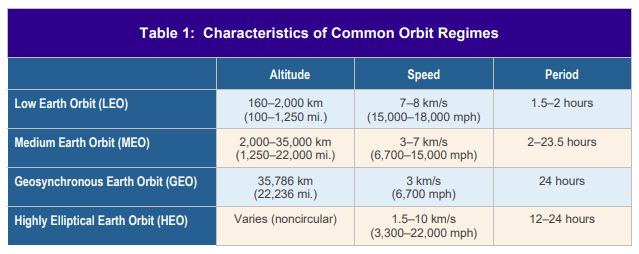Science fiction space movies can do a poor job of educating people about space. In the movies, hot-shot pilots direct their dueling space ships through space as if they’re flying through an atmosphere. They bank and turn and perform loops and rolls, maybe throw in a quick Immelman, as if they’re subject to Earth’s gravity. Is that realistic?
No.
In reality, a space battle is likely to look much different. With an increasing presence in space, and the potential for future conflict, is it time to think about what an actual space battle would look like?
The non-profit Aerospace Corporation thinks it’s time to consider what a real space battle would look like. Dr. Rebecca Reesman from the Aerospace Corporation’s Center for Space Policy and Strategy and her colleague James R. Wilson have written a paper on the topic of space battles. Its title is “The Physics of Space War: How Orbital Dynamics Constrain Space-to-Space Engagements.”
If past human affairs indicate the future, then the militarization of space will proceed. That’s despite talk of keeping space peaceful, and despite treaties that say the same. So it’s important that as more nations grow their presence in space, and as a competition for resources starts to cause problems, that the conversation around space conflict take a realistic turn.
That’s the case that the authors make in the introduction to their paper. “As the United States and the world discuss the possibility of conflict extending into space, it is important to have a general understanding of what is physically possible and practical. Scenes from Star Wars, books, and TV shows portray a world very different from what we are likely to see in the next 50 years, if ever, given the laws of physics.”
There’s never been a battle in space yet. But there has been some weapons-testing activity. China is working on anti-satellite weapons and has tested an anti-satellite missile. So has India. Russia is also working on anti-satellite capabilities, and the US is doing the same. The US actually destroyed one of their own satellites with a missile back in 1985.  An F-15A Eagle launched the ASM-135 during the final test in 1985, which destroyed the Solwind P78-1 satellite. Image Credit: By Paul E. Reynolds (USAF) – Originally downloaded from http://www.losangeles.af.mil/SMC/HO/SNAPSHOTS%20IN%20SMC%20HISTORY.htmImage is a cropped version of this: Image page(image ID DF-SC-88-08413), Public Domain, https://commons.wikimedia.org/w/index.php?curid=227452
An F-15A Eagle launched the ASM-135 during the final test in 1985, which destroyed the Solwind P78-1 satellite. Image Credit: By Paul E. Reynolds (USAF) – Originally downloaded from http://www.losangeles.af.mil/SMC/HO/SNAPSHOTS%20IN%20SMC%20HISTORY.htmImage is a cropped version of this: Image page(image ID DF-SC-88-08413), Public Domain, https://commons.wikimedia.org/w/index.php?curid=227452
This is likely just the tip of the iceberg when it comes to future conflict in space. None of this anti-satellite activity involved people traveling in spacecraft, and there may never be a need for crewed military spacecraft, according to the paper. “The space-to-space engagements in a modern conflict would be fought solely with un-crewed vehicles controlled by operators on the ground and heavily constrained by the limits physics imposes on movement in space.”
In the early days of the Space Age, while the Cold War was still raging, the superpowers imagined that conflict in space would largely be an extension of Earthly conflicts. The Soviets even designed space stations armed with a machine gun to defend against attack by American astronauts. The USA worked on similar ideas.
 A Soviet Almaz crewed space station at the Cosmonautics and Aviation Center in Moscow. Russia designed several types of military satellites and space stations, some armed with a machine gun, before abandoning the idea as too expensive. Image Credit: By Pulux11 – Own work, CC BY-SA 4.0, https://commons.wikimedia.org/w/index.php?curid=71718823
A Soviet Almaz crewed space station at the Cosmonautics and Aviation Center in Moscow. Russia designed several types of military satellites and space stations, some armed with a machine gun, before abandoning the idea as too expensive. Image Credit: By Pulux11 – Own work, CC BY-SA 4.0, https://commons.wikimedia.org/w/index.php?curid=71718823 But technological advances meant that those efforts were abandoned in favor of uncrewed satellites. “Eventually, both programs faltered. Instead,
improvements in technology and data transmission—the same developments that ultimately underpin our modern connected life—
made possible satellites that perform the same military functions envisioned for the earlier crewed programs.” Now space is dominated by satellites, with only the ISS hosting humans.
This will be the future, according to the paper. For the next 50 years or so, any conflicts in space will involve attacks on satellites. But not everything will be an outright attack. The authors outline four objectives in a space attack:
- Deceive an enemy so that they react in ways that hurt their interests.
- Disrupt, deny, or degrade an enemy’s ability to use a space capability, either temporarily or permanently.
- Destroy completely a space-based capability.
- Deter or defend against a counter-attacking adversary, either in space or on Earth.
Satellites move very predictably. They move quickly, but it’s relatively easy to predict their future position and to intercept them, in many cases. Some satellites can change their orbital height, but they have no real maneuverability and almost no way to avoid an attack.
“To describe how physics would constrain space-to-space engagements, this paper describes five key concepts: satellites move quickly, satellites move predictably, space is big, timing is everything, and satellites maneuver slowly.”p
Flight through Earth’s atmosphere isn’t exactly simple, but it is pretty intuitive. But in space, it’s completely different and isn’t accurately called flight. With no atmosphere and low gravity, things are very different. “Movement in space is counterintuitive to those accustomed to flight within Earth’s atmosphere and the chance to refuel,” the authors write. Space battles will likely be between satellites, and refueling will not be an option. In this image, an F-16 is refueling from a KC-135 Stratotanker. Image Credit: By U.S. Air Force – commons, Public Domain, https://commons.wikimedia.org/w/index.php?curid=88816208
Space battles will likely be between satellites, and refueling will not be an option. In this image, an F-16 is refueling from a KC-135 Stratotanker. Image Credit: By U.S. Air Force – commons, Public Domain, https://commons.wikimedia.org/w/index.php?curid=88816208
“Space-to-space engagements would be deliberate and likely unfold slowly because space is big and spacecraft can escape their predictable paths only with great effort. Furthermore, attacks on space assets would require precision because spacecraft and even ground-based weapons can engage targets in space only after complex calculations are determined in a highly engineered domain.” There would be no cadre of fighter pilots on standby, waiting to scramble and quickly launch. Instead, a space battle involving satellites is more of a mathematical exercise.
“This is true because physics puts constraints on what happens in space. Only by mastering these constraints can other questions such as how to fight and, most importantly, when and why to fight a war in space, be explored,” they write.
A satellite’s orbit is predictable because of the relationship between speed, altitude, and the orbit’s shape. At lower altitudes, satellites can experience atmospheric drag. Also, the Earth isn’t a perfect sphere. But those factors can be accounted for in an attack. “To deviate from their prescribed orbit, satellites must use an engine to maneuver. This contrasts with airplanes, which mostly use air to change direction; the vacuum of space offers no such option,” they write.  Satellite orbits are predictable and don’t depend on the mass of the satellite. Image Credit: Reesman and Wilson 2020.
Satellite orbits are predictable and don’t depend on the mass of the satellite. Image Credit: Reesman and Wilson 2020.
The sheer volume of space is also a factor in a space battle. “The volume of space between LEO and GEO is about 200 trillion cubic kilometers (50 trillion cubic miles). That is 190 times bigger than the volume of Earth.”
So tracking satellites accurately in that volume of space will be a continuous challenge, since some will be designed to be undetected. But that’s not impossible; satellites are regularly tracked. And since they’re not very maneuverable, once a satellite’s orbit is detected, monitors can keep track of its trajectory.
The sheer volume of space also means that most space battles would be very short-lived. There won’t be any dogfights. “Space is big, which means that a space-to-space engagement is not going to be both intense and long. It can only be one or the other: either a short, intense use of a lot of Delta V for big effect or long, deliberate use of Delta V for smaller or persistent effects.”
Delta V is a change in velocity, and that requires fuel or propellant. But most satellites don’t have the capability to change their velocity, and the few that might are severely fuel-limited.
“Operators of an attack satellite may spend weeks moving a satellite into an attack position during which conditions may have changed that alter the need for or the objective of the attack.” And if the defending satellite is able to only slightly change its own path in response to an attack, then the attacking satellite may not have the capability or the fuel to change its own path to intercept it.
The authors also point out that timing is everything. Even if an attacking satellite can orient itself into the same orbital path as its target, there’s still no guarantee of proximity.
“The nature of conflict often requires two competing weapons systems to get close to one another,” the report says. The authors use the example of an aircraft carrier needing to get close to its target, and another of jet fighters that also need to be close to each other. The same thing is true of satellites in space.
“Getting two satellites to the same altitude and the same plane is straightforward (though time and ?V consuming), but that does not mean they are yet in the same spot. The phasing—current location along the orbital trajectory—of the two satellites must also be the same. Since speed and altitude are connected, getting two satellites in the same spot is not intuitive.” Instead, it takes perfect timing and meticulous preparation. Satellites change their position in their orbit with phasing maneuvers. Any time a satellite raises its orbit, it slows down and appears to be moving backward in relation to its prior orbit and altitude. This is how a satellite can “catch up” to another satellite. Image Credit: Reesman and Wilson 2020.
Satellites change their position in their orbit with phasing maneuvers. Any time a satellite raises its orbit, it slows down and appears to be moving backward in relation to its prior orbit and altitude. This is how a satellite can “catch up” to another satellite. Image Credit: Reesman and Wilson 2020.
The authors also discuss another method of approaching a target called “plane matching,” A satellite maneuvers itself so that its orbital plane is aligned with a target. That has the advantage of allowing the attacker to dictate the time of the engagement. “By not initiating threatening maneuvers immediately, an attacker may try to seem harmless while waiting for an optimal time to attack,” the authors explain.
But none of these maneuvers happen quickly. “The physics of space dictate that kinetic space-to-space engagements be deliberate with satellites maneuvering for days, if not weeks or months, beforehand to get into position to have meaningful operational effects,” they write. But it can still be done.
And once the interception has been set up, “…many opportunities can
arise to maneuver close enough to engage a target quickly.”
There are natural limits to how maneuvering satellites in LEO can do. On one hand, some phasing maneuvers can send the satellite into the Earth’s atmosphere where it will be burned up. On the other, it could be sent too far away from LEO, into the Van Allen Belts. So there are constraints on a satellite’s maneuverability. If a satellite performs a forward phasing maneuver with a first burn of 115 m/s or more of ?V, it will reenter Earth’s atmosphere and burn up. Similarly, if the satellite performs a backward phasing maneuver with a first burn of 350 m/s or more of ?V, it will experience high radiation in the Van Allen belts. These two facts create natural bounds for how quickly a satellite can maneuver in LEO (500 km or 310 mi.). Image Credit: Reesman and Wilson 2020.
If a satellite performs a forward phasing maneuver with a first burn of 115 m/s or more of ?V, it will reenter Earth’s atmosphere and burn up. Similarly, if the satellite performs a backward phasing maneuver with a first burn of 350 m/s or more of ?V, it will experience high radiation in the Van Allen belts. These two facts create natural bounds for how quickly a satellite can maneuver in LEO (500 km or 310 mi.). Image Credit: Reesman and Wilson 2020.
Satellites in geostationary orbits maintain the same relative position over Earth, so some of the mechanics of attacking and defending are different. But overall, the same constraints are still in place. It takes time and energy to maneuver in space, regardless of the type of orbit.
But orbital and maneuverability considerations are only a part of what the report addresses.
The authors go on to discuss the types of attacks that can take place. Collisions, projectiles, and electronic jamming or disruption are covered in the paper. Each type has its own considerations and preparations.
But the authors also discuss the aftermath of some successful attacks: complications arising from debris. Additional debris could end up damaging other unintentional targets, like the attacker’s own satellites or those of a neutral nation. There have been three successful anti-satellite attacks: one by China, one by the USA, and India. The authors prepared a graphic to show the debris from each one.
 The density of debris is compared at different altitudes as a function of time after the ASAT intercepted (made contact with and destroyed) the target satellite. The Chinese test happened at a much higher altitude (856 km or 532 mi.) than the other two, creating long-lasting debris. Image Credit: Reesman and Wilson, 2020.
The density of debris is compared at different altitudes as a function of time after the ASAT intercepted (made contact with and destroyed) the target satellite. The Chinese test happened at a much higher altitude (856 km or 532 mi.) than the other two, creating long-lasting debris. Image Credit: Reesman and Wilson, 2020. The debris cloud from an attack is denser immediately after the attack and spreads out quickly. Even though debris density is lowered quickly, the debris spreads out over a larger area and is still hazardous.  This image shows the debris cloud from the Indian ASAT in 2019. The panels show the cloud at 5 min., 45 min., 90 min., 1 day, 2 days, 3 days, and 6 days after the attack. Image Credit: Reesman and Wilson 2020.
This image shows the debris cloud from the Indian ASAT in 2019. The panels show the cloud at 5 min., 45 min., 90 min., 1 day, 2 days, 3 days, and 6 days after the attack. Image Credit: Reesman and Wilson 2020.
The paper is a clear presentation of all of the difficulties with space battles and how much different they would be compared to air-to-air battles. But some other considerations that are still important are outside its scope.
What happens when one nation deduces that their satellites are about to be attacked? They won’t sit on their thumbs. They’ll likely denounce, threaten, and even retaliate here on Earth. A space attack could end up being a flashpoint for another terrestrial war.
There could end up being an arms race in space, where nations compete to outspend each other on space weaponry and other technology. That’s a huge strain on resources for a world that should be focused on meeting the challenge of climate change.
And, where does it all end? War in orbit? War on the Moon? War on Mars? When will humanity figure it out and just stop?
One day, maybe, there’ll be a final war before we give it all up. But that won’t likely be in the next 50 years.
And if there is a war in the next 50 years or so, it may involve satellites, and it may look a lot like how the authors of this report have laid it out: slow, calculated, and deliberate.
